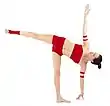Bharadvajasana
Bharadvajasana (Sanskrit: भरद्वाजासन; IAST: Bharadvājāsana) or Bharadvaja's twist is a twisting āsana in modern yoga as exercise.[1]
.JPG.webp)
Etymology and origins
The asana is dedicated to the sage Bharadvāja[2] who was one of the Seven Great Sages or Rishi.[3] He was the father of Drona, a master of military arts and the royal guru to Kauravas, Pandavas and the Devastras,[4] the princes who fought the great war of the Mahābhārata.
A different asana is illustrated under the name Bharadvajasana in the 19th century Sritattvanidhi; it somewhat resembles Mayurasana with the legs in Padmasana, but as drawn it would be impossible to perform.[5]
The pose currently known by the name Bharadvajasana is a modern one, first seen in the 20th century.[6] It is described in the works of two of Krishnamacharya's pupils, B. K. S. Iyengar's 1966 Light on Yoga[7] and Pattabhi Jois's Ashtanga Vinyasa Yoga.[6]
Description

Bharadvājāsana is a seated spinal twist. It has three main forms:
- Bharadvājāsana I is the basic form in which the legs articulated as in Vīrāsana dropped to one side one foot on the floor and the other's ankle cradled in the arch of the foot below.[8]
- Bharadvājāsana II is the advanced form requiring high hip mobility in which one leg articulated as in Padmasana (lotus position), while the other leg is articulated as in Vīrāsana (hero pose).[9]
- Bharadvājāsana on chair is a variant performed sitting sideways on an armless chair. This does not require hip mobility; the arms grasp the back of the chair to assist with the twist.[10]
See also
- Marichyasana, a sitting twist with one leg straight
- Matsyendrasana, a sitting twist with one knee up
References
- YJ Editors 2012.
- Iyengar 1979, p. 251—252.
- Inhabitants of the Worlds Mahanirvana Tantra, translated by Arthur Avalon, (Sir John Woodroffe), 1913, Introduction and Preface
- Hopkins 1915.
- Sjoman, Norman E. (1999). The Yoga Tradition of the Mysore Palace. Abhinav Publications. pp. 74 and plate 5 (pose 28). ISBN 978-81-7017-389-2.
- Sjoman, Norman E. (1999). The Yoga Tradition of the Mysore Palace. Abhinav Publications. p. 100. ISBN 81-7017-389-2.
- Iyengar, B. K. S. (1979) [1966]. Light on Yoga: Yoga Dipika. Unwin Paperbacks. pp. 251–254. ISBN 978-1855381667.
- Mehta 1990, p. 72.
- Mehta 1990, p. 77.
- Mehta 1990, p. 71.
Sources
- YJ Editors (2012). "Bharadvaja's Twist". Yoga Journal. Retrieved 2012-12-10.
- Hopkins, Edward Washburn (1915). Epic Mythology. Noble Offset Printers. ISBN 978-0819602282.
- Iyengar, B. K. S. (1979). Light on Yoga. Schocken. p. 62. ISBN 978-0-8052-1031-6.
- Mehta, Silva; Mehta, Mira; Mehta, Shyam (1990). Yoga: The Iyengar Way. Dorling Kindersley.
- Sinha, S. C. (1996). Dictionary of Philosophy. Anmol Publications. ISBN 978-81-7041-293-9.
_from_Jogapradipika_1830_(detail).jpg.webp)
